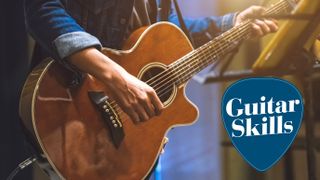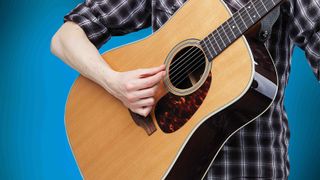Use the CAGED system to play guitar chords across the fretboard quickly and easily
Unleash the beast and unlock your guitar neck with this well-established system

Unlock your fretboard and play chords across the neck by deploying this ingenious system. You’ll never look at the guitar the same way again!
The system we’re talking about is known as the CAGED system, so called because it refers to those beginner chord shapes that we all know in open position (ie, open C, A, G, E and D chords).

The idea of this technique is to rearrange these five shapes as barre chords and move them around the fretboard. Sounds tough? Well, no. It’s actually easy to learn because all the shapes link together in a logical way - and it works with minor chords too.
Rather than repeat lots of boring exercises, in this lesson we’ve tried to make these examples as musical and ‘real world’ as possible. From Jimi Hendrix to John Mayer, all the great guitarists use these shapes, perhaps without even thinking about them, simply finding the best one for the right moment.
Generally, it’s good practice to avoid big leaps up or down the fretboard as this can be awkward for the fingers, but the real beauty of this system is that you can experiment to find what sounds good to you.
Major chords

This is the all-important starting point. Learn each of these shapes, noting the slightly awkward note in the G shape that we’ve put in brackets - most guitarists don’t tend to play this note. The bracketed note in the E shape can be played, but it illustrates that you don’t have to play every note of the chord. Hendrix rarely would!
Minor chords

This reggae groove passes through all five CAGED chords, this time using minor shapes and in a much more musical way. If in doubt, refer back to the five open-position chords (and their minor variants) to see how our rhythm part relates to those crucial basic shapes. Note that the shapes used are written in brackets over the music.
Get the MusicRadar Newsletter
Want all the hottest music and gear news, reviews, deals, features and more, direct to your inbox? Sign up here.
Major/minor connection

Notice how simply changing the bottom note of the E chord turns it into C#m7 - all the other notes stay the same. This ‘sharing’ of common notes is key to unlocking the fretboard and learning how shapes ‘join up’. If the final Amaj7 chord had, for example, an 11th fret C# note on the fourth string, it would transform into a C#m chord.
Dominant 7th workout

This tricky sequence places every chord a 4th interval higher than its predecessor. Don’t worry if you don’t understand the theory - it doesn’t matter for now. The key here is the efficient movement of chords. With so many potential CAGED shapes at your disposal you can play this progression with no big moves up or down the fretboard.
Practice Plan
- Two minutes: Play through one exercise slowly
- One minute: Experiment with the number of notes in each chord
- One minute: Move and adapt the chords to new fretboard positions
- One minute: Play through the exercise up to speed
- Try the other examples
Once you’ve tried the tab exercises and had a go at creatively adapting them in different areas of the fretboard, you’ll start to see these connections like a jigsaw puzzle all over the neck - this can have a huge impact on your versatility as a player. Experiment by trying one or two of these different shapes in your next jam.
It could be as simple as playing a familiar chord progression in a different area of the fretboard. Integrate these ideas and your knowledge of the fretboard and your ability to improvise will increase.
MusicRadar is the number one website for music-makers of all kinds, be they guitarists, drummers, keyboard players, DJs or producers...
- GEAR: We help musicians find the best gear with top-ranking gear round-ups and high-quality, authoritative reviews by a wide team of highly experienced experts.
- TIPS: We also provide tuition, from bite-sized tips to advanced work-outs and guidance from recognised musicians and stars.
- STARS: We talk to musicians and stars about their creative processes, and the nuts and bolts of their gear and technique. We give fans an insight into the craft of music-making that no other music website can.
Most Popular


